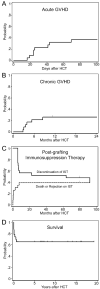Outcome of allogeneic hematopoietic cell transplantation from HLA-identical siblings for severe aplastic anemia in patients over 40 years of age
- PMID: 20403449
- PMCID: PMC2934906
- DOI: 10.1016/j.bbmt.2010.04.005
Outcome of allogeneic hematopoietic cell transplantation from HLA-identical siblings for severe aplastic anemia in patients over 40 years of age
Abstract
Patients with severe aplastic anemia (SAA) over 40 years of age are often not offered treatment with hematopoietic cell transplantation (HCT) because of concerns about treatment-related morbidity or mortality. To evaluate this risk, we analyzed outcomes after allogeneic HCT from HLA-identical sibling donors for all older patients with SAA at our center since 1988. The 23 consecutive patients ranged in age from 40 to 68 years. The conditioning regimen was cyclophosphamide (200 mg/kg) and horse antithymocyte globulin. Methotrexate and cyclosporine were given for postgrafting immunosuppression. The cumulative incidences of grades II, III, and IV acute graft-versus-host-disease were 30%, 4%, and 0%, respectively; that for chronic GVHD was 26%. With a median follow-up of 9.1 years, overall survival was 65%. Documented infections within 1 month before HCT were significantly associated with risk of early treatment-related mortality (P < .001). The median time to discontinuation of posttransplant immunosuppression was 6.2 (range: 5.9-92.0) months. Three patients developed superficial basal cell carcinoma between 5.5 and 15 years after HCT. Our data favor a practice of extending HLA-identical sibling HCT for treatment of SAA in patients older than 40 years of age who are without significant medical comorbidities.
Copyright © 2010 American Society for Blood and Marrow Transplantation. Published by Elsevier Inc. All rights reserved.
Conflict of interest statement
The authors have no conflicts of interest to disclose.
Figures

References
-
- Camitta BM, Thomas ED, Nathan DG, et al. Severe aplastic anemia: A prospective study of the effect of early marrow transplantation on acute mortality. Blood. 1976;48:63–70. - PubMed
-
- Storb R, Etzioni R, Anasetti C, et al. Cyclophosphamide combined with antithymocyte globulin in preparation for allogeneic marrow transplants in patients with aplastic anemia. Blood. 1994;84:941–949. - PubMed
-
- Young NS. Acquired aplastic anemia (Review) Ann Intern Med. 2002;136:534–546. - PubMed
-
- Deeg HJ, Leisenring W, Storb R, et al. Long-term outcome after marrow transplantation for severe aplastic anemia. Blood. 1998;91:3637–3645. - PubMed
-
- Storb R, Blume KG, O’Donnell MR, et al. Cyclophosphamide and antithymocyte globulin to condition patients with aplastic anemia for allogeneic marrow transplantations: the experience in four centers. Biol Blood Marrow Transplant. 2001;7:39–44. - PubMed
Publication types
MeSH terms
Substances
Grants and funding
LinkOut - more resources
Full Text Sources
Medical
Research Materials

